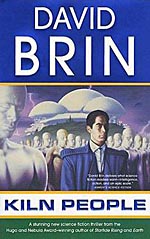
![]() couchtomoon
couchtomoon
6/24/2015
![]()
Also known as Kil'n People, which is why I didn't expect a book about clay people. I thought it was going to be about some imaginary tribal culture. Maybe from space. But, no. It's about clay people. That you make in kilns. Kiln clones. ALSO KNOWN AS GOLEMS.
In case you're just joining me in my reading saga, I just read a book with 229 mentions of the word golem. I'm a bit golemed out.
"Golemetry is an interruption," I read somewhere once.
Private Detective Albert Morris lives in a future world where downloading one's mind into into temporary clay bodies is a common and daily occurrence. Morris relies heavily on his dittos to carry out his hard and dangerous work while he stays home and chills, waiting for his clones (the lucky ones that survive, that is) to return and upload their memories into his mind so he can solve his cases. One day, however, several of his ditectives become personally involved in various ditplots, and things become mortarly inclone-venient.
And the clay puns abound. ("Peditstrian" is one example of Brin's word play. Not joking.)
If we look into the pores of this brittle surface, there is an undercurrent of something deeper going on. A criticism of the industrialization of humanity. Disposable culture. Experience without risk. With the convenience of dittos, the world is transformed into something depersonalized and gritty. Bodies of used up dittos litter the streets and overfill the bins. City centers transform to pleasure centers where specialized service golems provide any service imaginable, dangerous or otherwise. Meanwhile, the real people stay at home, underemployed and overeducated and overexperienced, waiting to upload more golemic memories. And what constitutes "real people?"
Tantalizing in that context, but don't forget this book is about hi-tech clones... made of clay. A premise this absurd that would be more effective if shorter--it was born of a David Brin short story - and even better if modeled after absurd SF of the fifties. A premise about ditto ditectives can't withstand 600 pages of plot because it's too flimsy to suspend disbelief for so long. I mean, clay clones? Really?

How I pictured the clay clones of David Brin's Kiln People. The materials science field in this world needs help.
Or this. Frightening.
In a sense, this novel has an Ancillary Justice feel with its multiple incarnations of one downloaded consciousness, and in some ways it explores this theme more deeply by imbuing each clone with experiences independent of their progenitor Albert. In one case, the download goes awry and a clone is born with an independent personality--termed a "frankie"--who quits his work with Albert to pursue his own agenda. Albert's a nice guy, so he's cool about it, but this idea of slavery of the consciousness would be a fascinating subject to explore, and would help develop reader empathy for these weird dittos. But although Brin hints at it, the plot is mostly concerned with crime fiction tropes such as chasing down a clone-voluted corporate clone-spiracy.
I should add that many critics of this novel complain that the rotating first-person perspectives of the clones isn't differentiated enough, and every clone reads too similarly to be interesting or noteworthy. The audiobook experience improves on this issue with the narrator voicing slight differences for each clone character. (The frankie clone is a bit whiny.)
One thing that Brin does get right, although only at the surface level, is his attention to skin, er, clay color. Each ditto is assigned a color based on their expected duties: green for general errand running, ebony for intellectual tasks, gray for diplomacy, ivory for the sex industry, etc., while the general human population is what is often termed "human brown." Although Brin doesn't much pursue this stratification at any emotional level, at least he subverts, rather than reinforces, our own social stereotypes by inventing his own system.
But ultimately, 600 pages is too long to entertain such an absurd premise. As the plot attempts to ditour and ditstract, inevitable questions arise in the reader's mind: How can they be made of clay? Can clay be that mobile? If this particular clay is made of high-tech flexible polymers, why are clones pockmarked after a day of basic activity? And, if clay clones are brittle enough to be covered in pockmarks from daily dings, how can the limbs be flexible enough to run or hold things? Wouldn't the impact of running shatter their feet?
After about 200 pages, my ditsbelief suspension system wore out.
http://couchtomoon.wordpress.com